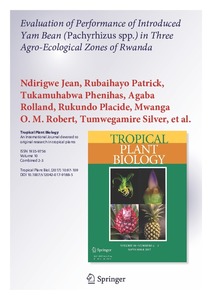| dc.contributor.author | Ndirigwe, J. |
| dc.contributor.author | Rubaihayo, P.R. |
| dc.contributor.author | Tukamuhabwa, P. |
| dc.contributor.author | Agaba, R. |
| dc.contributor.author | Rukundo, P. |
| dc.contributor.author | Mwanga, R.O.M. |
| dc.contributor.author | Tumwegamire, S. |
| dc.contributor.author | Kamarirwa, V. |
| dc.contributor.author | Kayinamura, E. |
| dc.contributor.author | Wolfgang, J.G. |
| dc.date.accessioned | 2019-12-04T11:11:25Z |
| dc.date.available | 2019-12-04T11:11:25Z |
| dc.date.issued | 2017-09 |
| dc.identifier.citation | Ndirigwe, J., Rubaihayo, P., Tukamuhabwa, P., Agaba, R., Rukundo, P., Mwanga, O.M.R., ... & Wolfgang, J.G. (2017). Evaluation of performance of introduced yam bean (Pachyrhizus spp.) in three agro-ecological zones of Rwanda. Tropical Plant Biology, 10(2-3),1-13. |
| dc.identifier.issn | 1935-9756 |
| dc.identifier.uri | https://hdl.handle.net/20.500.12478/2426 |
| dc.description | Article purchased; Published online: 25 May 2017 |
| dc.description.abstract | The yam bean (Pachyrizhus spp) was recently introduced as a root crop with high-yield potential, considerable protein and micro-nutrient concentration to investigate its potential for food production in Rwanda. Except for Chuin types (Pachyrizhus tuberosus) which have high storage root dry matter (RDM) (26 to 36%), most accessions are consumed raw and are reported to have low RDM. The present study aimed to evaluate and identify adapted high yielding yam bean accessions in major agro-ecological zones of Rwanda. Field experiments with 22 accessions were conducted in 2012 at three research sites representing the major agro-ecologies of Rwanda. Strict reproductive pruning was followed to enhance fresh storage root yields. Across locations, ANOVA indicated highly significant differences (p < 0.01) for genotypes (G), locations (L), seasons (S) and G x L effects for storage root yield, vine yield and harvest index and accounted for 21.88%, 43.41%, 1.43% and 13.25% of the treatment sum of squares, respectively. The GGE bi-plot revealed that EC209018 is high yielding but unstable. However, genotypes, AC209034, AC209035 and EC209046, were outstanding in terms of adaptation and relative stability across the 3 locations, suggesting consistent root yields irrespective of location and environmental conditions. The GGE scatter plot showed that all genotypes formed one mega-environment for storage root yield (Karama, Musanze and Rubona) and two mega-environments for biomass yield (Karama and Rubona as one mega-environment and Musanze the second one). This study revealed that Karama is the most suitable environment for evaluation and selection of yam bean for yield components in Rwanda. |
| dc.description.sponsorship | Directorate-General for Development Cooperation and Humanitarian Aid, Belgium |
| dc.format.extent | 97-109 |
| dc.language.iso | en |
| dc.subject | Yams |
| dc.subject | Yam Bean |
| dc.subject | Genotypes |
| dc.subject | Pachyrizhus |
| dc.subject | Gxe |
| dc.subject | High Storage Roots Yield |
| dc.subject | Harvest Index |
| dc.subject | Gge Bi-Plot |
| dc.title | Evaluation of performance of introduced yam bean (Pachyrhizus spp.) in three agro-ecological zones of Rwanda |
| dc.type | Journal Article |
| dc.description.version | Peer Review |
| cg.contributor.crp | Roots, Tubers and Bananas |
| cg.contributor.affiliation | Makerere University |
| cg.contributor.affiliation | Rwanda Agriculture Board |
| cg.contributor.affiliation | International Potato Center |
| cg.contributor.affiliation | International Institute of Tropical Agriculture |
| cg.contributor.affiliation | National University of Rwanda |
| cg.coverage.region | Africa |
| cg.coverage.region | Central Africa |
| cg.coverage.country | Rwanda |
| cg.isijournal | ISI Journal |
| cg.authorship.types | CGIAR and developing country institute |
| cg.iitasubject | Yam |
| cg.journal | Tropical Plant Biology |
| cg.howpublished | Formally Published |
| cg.accessibilitystatus | Open Access |
| local.dspaceid | 92531 |
| cg.targetaudience | Scientists |
| cg.identifier.doi | http://dx.doi.org/10.1007/s12042-017-9188-5 |

